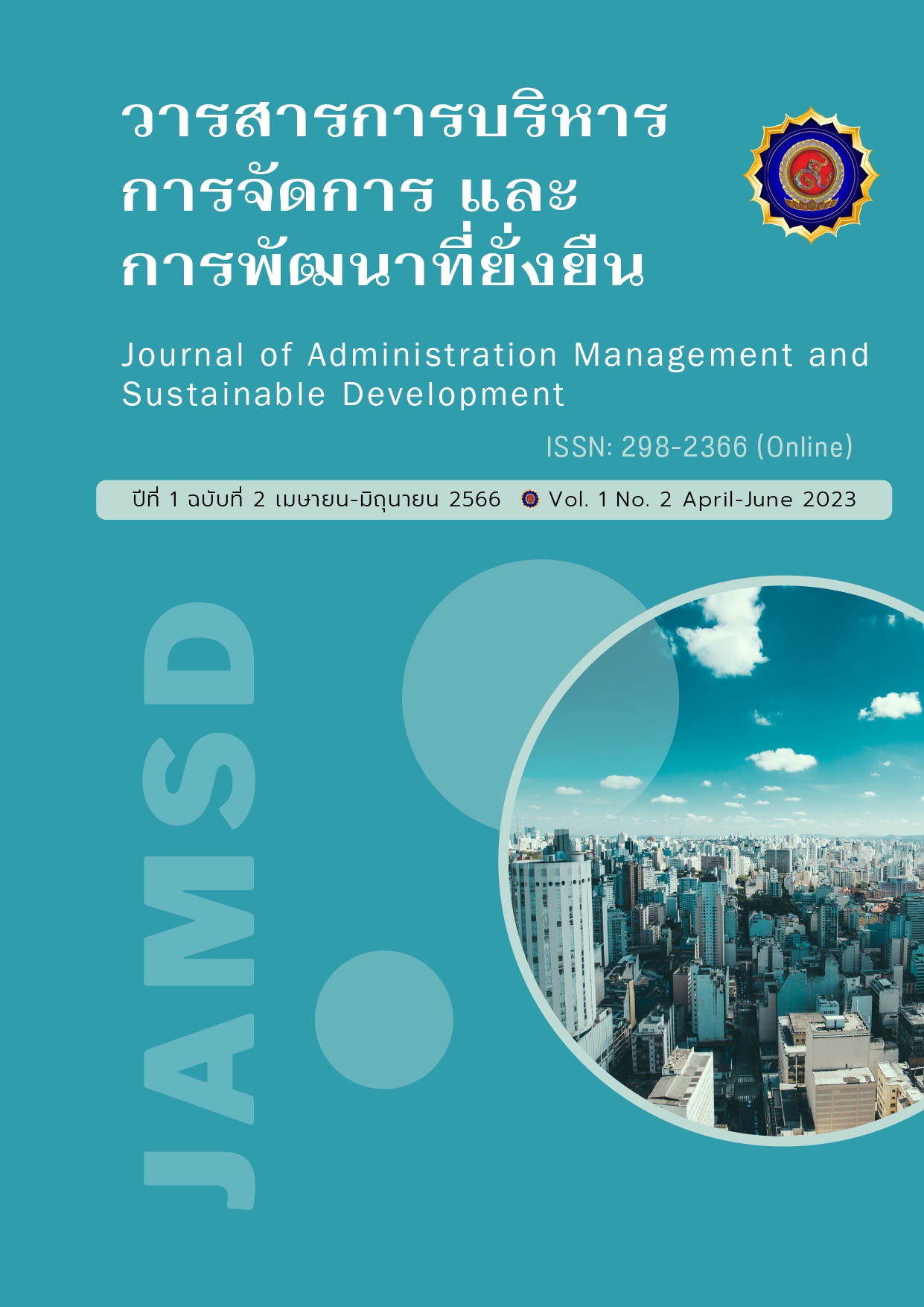Community policing: Innovation in public participation in sustainable crime prevention and suppression
Keywords:
Innovation, Community policing, Partnership, CrimeAbstract
Police work in an era of social change It is necessary to change the process or work style. From the past, the duty of maintaining peace and order and catching illegal offenders was the responsibility of the police alone and the police mainly used law enforcement methods, but such methods were not able to reduce crime in society. Later, when the concept of Community Policing was used in operations, it resulted in integration with the public and various agencies. As Sir Robert Peel said, “The police are the people and the people are the police.” And with modern society's advancements in technology and innovation, Make the real world society become a digital society the era of digital transformation was born. That humans have applied technology in daily life, which the RTP Cyber Village project is a policy of the Royal Thai Police that gives the police station every location operates using online platforms to help with work.
The principles of the Community Policing concept and the RTP Cyber Village project are therefore considered innovations in management and work methods to create public participation in crime prevention. The police must build trust. Create an experience create awareness build belief and create work that is transparent and fair for the public to see and trust Therefore, it will be possible to build sustainable cooperation with the public as a "Partnership" between the police and the public.
References
กองแผนงานอาชญากรรม. (2566). โครงการ SMART SAFETY ZONE 4.0. สำนักงานตำรวจแห่งชาติ.
กองแผนงานอาชญากรรม. (2563). ผลการปฏิบัติตามแผนป้องกันปราบปรามอาชญากรรมของสำนักงานตำรวจแห่งชาติ ประจำปีงบประมาณ พ.ศ. 2563. สำนักงานตำรวจแห่งชาติ.
จตุพร บานชื่น. (2546). ปัญหาสังคม: อาชญากรรม. กรุงเทพฯ: คณะสังคมศาสตร์ มหาวิทยาลัยเกษตรศาสตร์.
จีรวัฏฐ์ บุญวัฒนาภรณ์. (2556). ผลสัมฤทธิ์การบริหารจัดการของกองบังคับการปราบปรามกองบัญชาการตำรวจสอบสวนกลาง สำนักงานตำรวจแห่งชาติ. วิทยานิพนธ์ปรัชญาดุษฎีบัณฑิต สาขาวิชารัฐประศาสนศาสตร์ มหาวิทยาลัยศรีปทุม.
ชรินทร์ทิพย์ ปั้นสุวรรณ. (2565). แนวทางการกำกับดูแลการรับมือภัยคุกคามความมั่นคงปลอดภัยไซเบอร์ขององค์กรในยุคดิจิทัล. วิทยานิพนธ์ปริญญาศิลปศาสตรดุษฎีบัณฑิต สาขาวิชาอาชญาวิทยาและงานยุติธรรม ภาควิชาสังคมวิทยาและมานุษยวิทยา. จุฬาลงกรณ์มหาวิทยาลัย.
ชาญคณิต กฤตยา สุริยะมณี. (2555). การนำกลยุทธ์แบบ Community Policing มาประยุกต์ใช้ในการป้องกันอาชญากรรมในเขตเมือง: กรณีศึกษา ชุมชนในเขตลาดพร้าว บางนา และบางพลัด กรุงเทพมหานคร. วารสารกระบวนการยุทติธรรม. (5), 49-71
ชำนิ คนไว (พันตำรวจโท). (2560). ปัญหาอาชญากรรมในสังคม. วารสารแสงอิสาน, 14(2), 28-41.
ณรงค์ ทรัพย์เย็น และธงชาติ รอดคลองตัน. (2551). คู่มือตำรวจ เล่มที่ 6 หมวดวิชาป้องกันปราบปรามอาชญากรรม. กรุงเทพฯ: โรงพิมพ์ตำรวจ.
ดิเรกฤทธิ์ บุษยธนากรณ์. (2563). แบบจำลองการคาดคะเนปัจจัยที่เป็นข้อบ่งชี้ลักษณะอาชญากรรม ลูกผสมในสังคมไทย. วิทยานิพนธ์ปรัชญาดุษฎีบัณฑิต. จุฬาลงกรณ์มหาวิทยาลัย.
ดิเรกฤทธิ์ บุษยธนากรณ์. วิชาการตำรวจ. (2560). ตำรวจไทย 4.0. ออนไลน์. เข้าถึงได้จาก http://preeda44.blogspot.com/2017/01/4.html สืบค้นเมื่อ 9 ตุลาคม 2566.
ดิเรกฤทธิ์ บุษยธนากรณ์. (2561). ทฤษฎีตำรวจสัมพันธ์. ออนไลน์. เข้าถึงได้จากhttps://www.scribd.com/document/371232880 สืบค้นเมื่อวันที่ 10 ตุลาคม 2566.
ภาคิน ดำภูผา. (2561). การประเมินการนำนโยบายการช่วยเหลือเหยื่ออาชญากรรมไปสู่การปฏิบัติ. วิทยานิพนธ์ หลักสูตรปริญญาศิลปศาสตรดุษฎีบัณฑิต สาขาวิชาอาชญาวิทยาและงานยุติธรรม ภาควิชาสังคมวิทยาและมานุษยวิทยาคณะรัฐศาสตร์ จุฬาลงกรณ์มหาวิทยาลัย.
วสัน คงนิล (พันตำรวจโท). 2558. อาสาสมัครตำรวจชุมชนมีส่วนร่วมแก้ปัญหาการแพร่ระบาดยาเสพติดในเขตพื้นที่ของสถานีตำรวจภูธรธัญบุรี จังหวัดปทุมธานี. การค้นคว้าอิสระหลักสูตรรัฐศาสตรมหาบัณฑิต (การเมืองการปกครอง) สาขาวิชาการเมืองการปกครองสำหรับนักบริหาร. มหาวิทยาลัยธรรมศาสตร์.
ไวพจน์ กุลาชัย และคณะ. (2562). ต้นเหตุแห่งความไว้วางใจตำรวจและผลกระทบต่อการปฏิบัติตามกฎหมายและการให้ความร่วมมือกับตำรวจ. โครงการวิจัยประเภทงบประมาณเงินรายได้ (เงินอุดหนุนจากรัฐบาล) ประจำปีงบประมาณ พ.ศ. 2562. มหาวิทยาลัยบูรพา.
ศูนย์เทคโนโลยีสารสนเทศกลาง. (2565). สถิติฐานความผิดคดีอาญา (คดี 4 กลุ่ม) หน่วยงานทั่วประเทศ. กองแผนงานอาชญากรรม. สำนักงานตำรวจแห่งชาติ.
สุรพล ธนโกเศศ. (2556). สู้! อาชญากรรม. (พิมพ์ครั้งที่ 2). กรุงเทพฯ: กรุงเทพ.
สำนักงานตำรวจแห่งชาติ. (2565). พระราชบัญญัติตำรวจแห่งชาติ พ.ศ. 2565. (2565, 16 ตุลาคม). ราชกิจจานุเบกษา เล่ม 139 ตอนที่ 64 ก. สืบค้นจาก https://www.royalthaipolice.go.th/downloads/T_0001.pdf สืบค้น 17 มิถุนายน 2566
(2566). แนวคิดและหลักการ COPPS “ตำรวจกองปราบปรามผู้รับใช้ชุมชน (COP)”. สืบค้นจาก
https://chomtong.chiangmai.police.go.th/forum/index.php?topic=19.0 สืบค้น 8 กรกฎาคม 2566.
Clarke, Ronald V. & Eck, John E. (2003). Becoming a Problem-Solving Crime Analyst: In 55 Small Steps. London: jill Dando Institute of Crime Science.
Dario, Ortega, Anderez., Eiman, Kanjo., Amna, Amnwar., Shane, D., Johnson., David, Lucy. (2021). The Rise of Technology in Crime Prevention: Opportunities, Challenges and Practitioners Perspectives. arXiv: Computers and Society,
Gim, Su, Yeong. (2020). Crime prevention system.
Jacob, Torfing., Andreas, Hagedorn, Krogh., Anders, Ejrnæs. (2020). Measuring and assessing the effects of collaborative innovation in crime prevention. Policy and Politics, 48(3):397-423. doi: 10.1332/030557320X15788414270675
Norwahida, Zainal, Abidin., Novel, Lyndon., Mohd, Helmi, Abdul, Rahim. (2018). IMPAK PROJEK INOVASI PENCEGAHAN JENAYAH KAWASAN PERUMAHAN: ANALISA DARIPADA PANDANGAN KOMUNITI LOKAL (The Impact of Crime Prevention Project Innovation of Housing Area: Analysis of the Views of Local Communities). 13(5)
Robert, Stokes., Charlotte, Gill. (2020). In Support of Innovative Partnerships for Crime Prevention: The Byrne Criminal Justice Innovation Program. 1-22. doi: 10.1007/978-3-030-43635-3_1.






